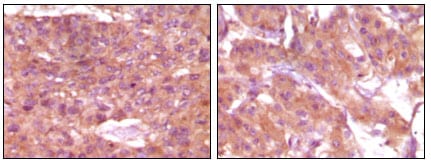
| WB | 咨询技术 | Human,Mouse,Rat |
| IF | 咨询技术 | Human,Mouse,Rat |
| IHC | 1/200 - 1/1000 | Human,Mouse,Rat |
| ICC | 技术咨询 | Human,Mouse,Rat |
| FCM | 咨询技术 | Human,Mouse,Rat |
| Elisa | 1/10000 | Human,Mouse,Rat |
| Aliases | SRAP; STRAA1 |
| Entrez GeneID | 10011 |
| clone | 1D4H8 |
| Host/Isotype | Mouse IgG1 |
| Antibody Type | Primary antibody |
| Storage | Store at 4°C short term. Aliquot and store at -20°C long term. Avoid freeze/thaw cycles. |
| Species Reactivity | Human |
| Immunogen | Purified recombinant fragment of SRA expressed in E. Coli. |
| Formulation | Ascitic fluid containing 0.03% sodium azide. |
+ +
以下是关于SRA(Scavenger Receptor Class A)抗体的3篇代表性文献摘要,供参考:
---
1. **文献名称**:*The role of scavenger receptors in immunity and inflammation*
**作者**:Krieger M, et al.
**摘要**:该综述系统阐述了清道夫受体A(SR-A)在先天免疫中的功能,包括其识别病原体相关分子模式(PAMPs)、介导巨噬细胞吞噬作用的能力,以及在动脉粥样硬化中促进氧化低密度脂蛋白摄取的作用。文中还讨论了针对SR-A的抗体在阻断炎症反应中的潜在应用。
---
2. **文献名称**:*Targeting SR-A with a monoclonal antibody inhibits atherosclerosis in murine models*
**作者**:Suzuki H, et al.
**摘要**:本研究开发了一种特异性抗SR-A单克隆抗体,并通过小鼠动脉粥样硬化模型验证其疗效。结果显示,该抗体能显著减少巨噬细胞浸润和斑块形成,表明SR-A可作为治疗动脉粥样硬化的潜在靶点。
---
3. **文献名称**:*Scavenger receptor-A modulates TLR4-mediated LPS response and regulates sepsis outcomes*
**作者**:Huang W, et al.
**摘要**:文章揭示了SR-A通过调控TLR4信号通路在脓毒症中的双重作用。利用抗SR-A抗体阻断实验证明,SR-A在早期抑制过度炎症反应,但在后期促进细菌清除,为靶向SR-A的抗体治疗时机提供了理论依据。
---
**备注**:若需获取具体实验方法或更早期经典文献(如SR-A基因克隆研究),可进一步补充说明。
Scavenger Receptor Class A (SRA), also known as SR-A or CD204. is a transmembrane glycoprotein predominantly expressed on immune cells such as macrophages and dendritic cells. It belongs to the scavenger receptor family, which plays a critical role in innate immunity by recognizing pathogen-associated molecular patterns (PAMPs) and modified self-molecules, including oxidized low-density lipoprotein (oxLDL). SRA facilitates the clearance of cellular debris, bacterial pathogens, and apoptotic cells through phagocytosis and endocytosis, contributing to immune homeostasis and inflammation regulation.
SRA antibodies are essential tools for studying the receptor's biological functions, including its involvement in atherosclerosis, autoimmune diseases, and infections. These antibodies enable detection of SRA expression in tissues or cells via techniques like flow cytometry, immunohistochemistry, and Western blotting. Additionally, functional blocking antibodies are used to investigate SRA's role in ligand binding and signaling pathways. Research has highlighted SRA's dual role: while it aids in host defense, its overactivation may exacerbate chronic inflammatory conditions. For instance, SRA promotes foam cell formation in atherosclerosis by internalizing oxLDL but also dampens excessive inflammation by modulating Toll-like receptor (TLR) signaling.
Therapeutic targeting of SRA using antibodies is being explored to treat diseases linked to dysregulated inflammation or lipid metabolism. However, complexities in its ligand specificity and signaling crosstalk necessitate further research to optimize clinical applications.
×